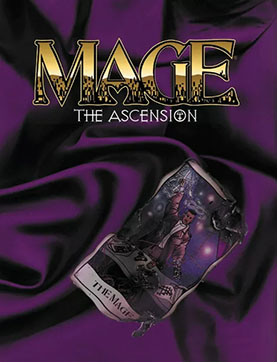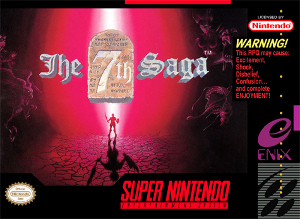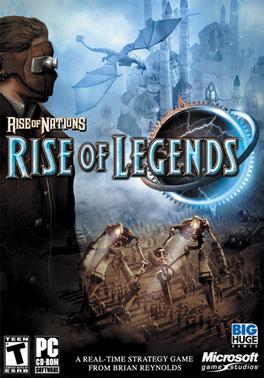
Mage: The Ascension is a role-playing game based in the World of Darkness, and was published by White Wolf Game Studio in 1993. The characters portrayed in the game are referred to as mages, and are capable of feats of magic. Magic in Mage is subjective rather than objective as it incorporates a diverse range of ideas and mystical practices as well as science and religion. A mage's ability to change reality is based on what they believe rather than an objective or static system of magic. In that regard, most mages do not resemble typical fantasy wizards.

Age of Wonders is a 1999 turn-based strategy game co-developed by Triumph Studios and Epic MegaGames, and published by Gathering of Developers.

Master of Magic is a single-player, fantasy turn-based 4X strategy game in which the player plays as a wizard attempting to dominate two linked worlds. From a small settlement, the player manages resources, builds cities and armies, and researches spells, growing an empire and fighting the other wizards.

The 7th Saga is a turn-based role-playing video game developed by Produce! and published by Enix for the Super Nintendo Entertainment System in 1993. The game made innovative use of a radar system during gameplay. It featured 7 playable characters of various types including humans, an elf, a dwarf, robots, a demon, and an alien. Each character has unique items and spells.

Warlords IV: Heroes of Etheria is a turn-based strategy video game developed by Infinite Interactive and published by Ubi Soft. It is the fourth in the Warlords series.

Chaos: The Battle of Wizards is a turn-based tactics video game released for the ZX Spectrum in 1985. It was written by Julian Gollop and originally published by Games Workshop. Based on Gollop's 1982 design for a board game / card game hybrid, Chaos received a positive reception and went on to influence various games, including Darwinia and King's Bounty, and spawned a sequel, Lords of Chaos, in 1990.
Birthright is a Dungeons & Dragons campaign setting that was first released by TSR in 1995. It is based on the continent of Cerilia on the world of Aebrynis, in which the players take on the role of the divinely-empowered rulers, with emphasis on the political rulership level of gameplay. The setting revolves around the concept of bloodlines: divine power gained by heroes and passed to their descendants. Characters with a bloodline create an aura of command known as Regency, which is measured in the game using regency points or RP. Using regency, characters acquire a domain composed of provinces and holdings. The development of these domains is as much a part of the game as development of the characters. The game uses three-month domain turns to model actions of rulers over nations in much the same way as Dungeons & Dragons uses combat rounds to simulate time to model the characters' actions in battle. In 1996, Birthright won the Origins Award for Best Roleplaying Supplement of 1995.

Archon II: Adept is a 1984 strategy/action video game developed by Free Fall Associates' Jon Freeman, Paul Reiche III and Anne Westfall, and published by Electronic Arts for various platforms. It takes place on a game board, except that when a piece lands on another player's piece, both are moved to a battle arena where they duel to the death. It is the sequel to the 1983 Archon: The Light and the Dark, which had a chess motif.

Rise of Nations: Rise of Legends is a science fantasy real-time strategy video game for Microsoft Windows, made by Big Huge Games, and published by Microsoft. It is a spin-off of the popular Rise of Nations, released in May 2006. However, rather than being a historical game, it is based in a fantasy world, where technology and magic co-exist. It was released on May 9, 2006 in North America and on various dates around May 26, 2006 in the rest of the world.

Magic: The Gathering – Battlegrounds is a real time strategy video game developed by Secret Level and published by Atari It is based on Magic: The Gathering collectible card game, with many fundamental differences. The game is based on the creation of heroes and mages that summon forth powerful monsters, spells, and abilities to defeat the enemy duelist. Duelists learn new magical spells by completing the campaign, with more and more spell books becoming available as the player progresses. Each spell is separated into one of 5 colors, each with their own strengths and weaknesses.

Wizardry VII: Crusaders of the Dark Savant is the seventh title in the Wizardry series of role-playing video games by Sir-Tech Software, Inc., preceding Wizardry 8 and succeeding Wizardry VI: Bane of the Cosmic Forge. It is also the second entry in the 'Dark Savant' trilogy. The game was published in 1992 by Sir-Tech, originally developed for DOS. In 1996 it was remade into Wizardry Gold, designed to work on Windows and Macintosh, and distributed by Interplay.

Langrisser (ラングリッサー), known as Warsong in North America, is a tactical role-playing game developed by Nippon Computer Systems (NCS). The first in the Langrisser series, it blended tactical warfare with RPG elements, similar to the Fire Emblem series. It was initially released for the Mega Drive/Genesis console and the PC Engine, the former version being published by Treco in America. The PC-Engine version was released under the title Langrisser: The Descendants of Light. It was later re-released alongside Der Langrisser in a compilation for the Sega Saturn and PlayStation. That compilation was released for the PlayStation Network in 2009. A full remake of Langrisser I & II was also released in 2019 on both Sony PlayStation 4 and Nintendo Switch and on PC in 2020, featuring new graphics and BGM and also new playable characters and multiple paths through the game for Langrisser I.

Dominions 3: The Awakening is a fantasy turn-based strategy game created by Illwinter and published in 2006 by Shrapnel Games. It is the third game in the Dominions series, preceded by Dominions: Priests, Prophets and Pretenders and Dominions II: The Ascension Wars. Illwinter's publishing contract with Shrapnel Games expired in November 2012 and Dominions 3 was republished on Desura in late December 2012 and soon after on GamersGate. Dominions 3 went through the Greenlight process and was released on Steam in September 2013.
Dominions: Priests, Prophets and Pretenders is a turn-based strategy game designed by Illwinter Game Design, in which up to fourteen "pretender gods" at a time each battle for global dominance. As of November 27, 2017, there have been four sequels: Dominions 2: The Ascension Wars, Dominions 3: The Awakening, Dominions 4: Thrones of Ascension, and Dominions 5: Warriors of the Faith which was released in 2017.

Brigandine is a turn-based strategy game for the PlayStation video game console, created by developer Hearty Robin and released in 1998. It was released in North America by Atlus the same year, under the title Brigandine: The Legend of Forsena. In 2000, Hearty Robin released an expanded version of the game called Brigandine: Grand Edition, which included multiplayer support, along other new features. In the game, the player chooses one of the nations of the fictional continent of Forsena, and has the goal of conquering the other nations by taking their castles, using troops composed of human commanders and fictional creatures. Although primarily a strategy game, it also includes some characteristics of tactical role-playing games.

Magic: The Gathering is a video game published by MicroProse in April 1997 based on the collectible card game Magic: The Gathering. It is often referred to as Shandalar after the plane of Shandalar, where the game takes place. The player must travel the land and fight random enemies to gain cards, and defeat five wizards representing the five colors. The player must prevent one color from gaining too much power, and defeat the planeswalker Arzakon, who has a deck of all five colors. Adventure and role-playing elements are present, including inventory, gold, towns, dungeons, random battles, and character progression in the form of new abilities and a higher life point total. An oversized version of Aswan Jaguar was included in the game box.

Dominions 4: Thrones of Ascension is a fantasy turn-based strategy game created and published by Illwinter in 2013. It is the fourth game in the Dominions series, preceded by Dominions: Priests, Prophets and Pretenders, Dominions II: The Ascension Wars and Dominions III: The Awakening and succeeded by Dominions 5: Warriors of the Faith released in 2017. Dominions 4 was initially released in Desura and later at GamersGate. It went through the Greenlight process and was released on Steam in September 2013, which became the most popular platform for looking for multiplayer games and discussions after Desura shut down. Some active communities can also be found on Discord and 4chan.
Dominions 5: Warriors of the Faith is a 4X turn-based strategy game created and published by Illwinter Game Design in 2017. It is characterized by simplistic graphics, a functional UI, and deep gameplay, with a roster of over 80 playable nations able to interact with more than 900 unique spells, 400 magic items, and thousands of different unit types. Players take on the role of pretenders, immortals with vast magical powers who are venerated as gods by a given nation. Their goal is to spread their faith, eliminate rival Pretenders and ascend as supreme god of their world. Compared to its predecessor, Dominions 4: Thrones of Ascension, Dominions 5 has been described as mainly a refinement, introducing real time combat for battles between armies, revising map generation, and a new system for blessings allowing the bonuses bestowed by gods to their nation to be customized.
Strixhaven: School of Mages is a Magic: The Gathering expansion set. It is not part of a block. The set was released in April 2021.
The Last Spell is a 2021 rogue-lite, tactical role-playing game developed by French studio Ishtar Games and published by The Arcade Crew. The game released into early access on Steam in June 2021. The final version of the game released on March 9, 2023, on the same day as the launch of the console versions for Nintendo Switch, PlayStation 4, and PlayStation 5. The game is available in English, French, Chinese, and Japanese.














